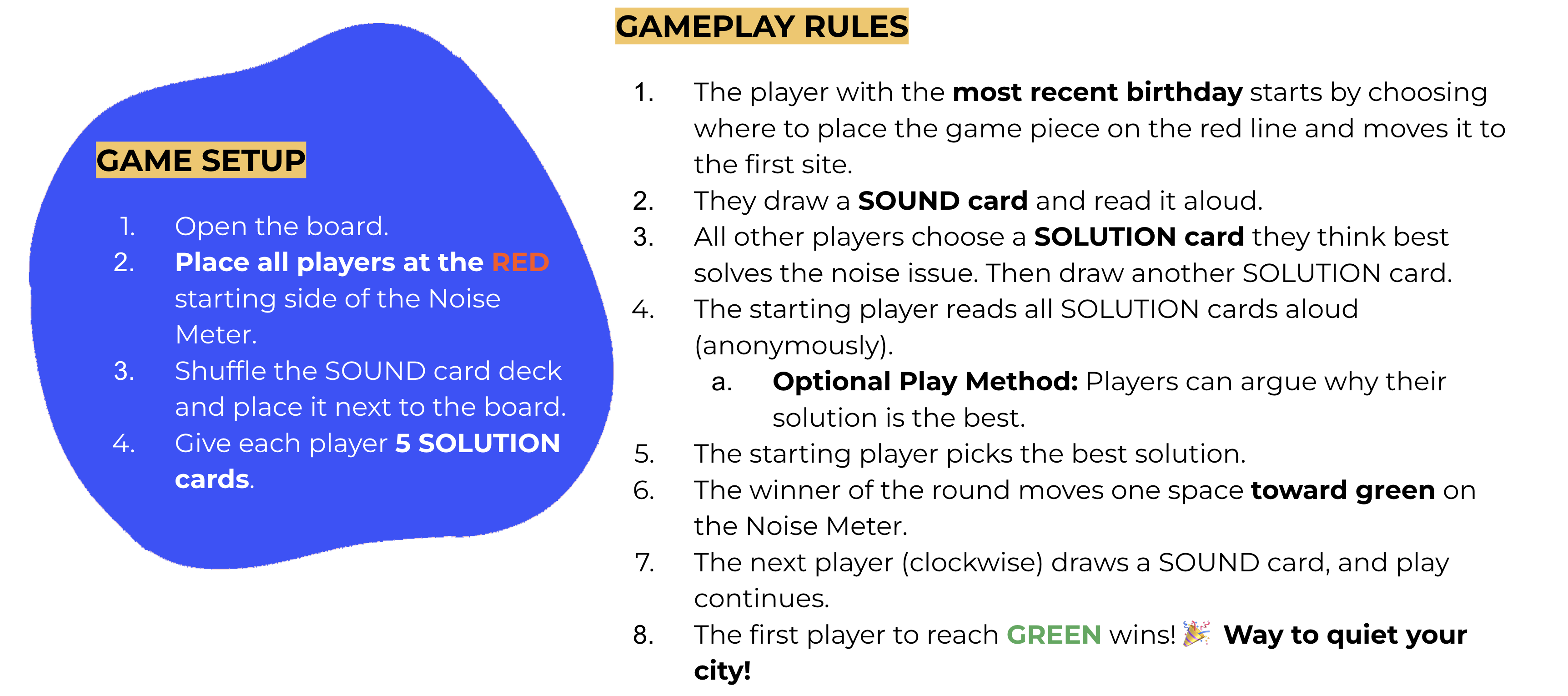Through this workshop, we developed “Clean up the Noisy City,” an educational and interactive game designed to raise children’s awareness of urban soundscapes. In this engaging experience, players take on the role of city problem-solvers, working together to identify, assess, and mitigate disruptive noises using creative solutions.
The game is played through a structured yet dynamic process: players draw SOUND cards representing real-world urban noise challenges and propose solutions from their hand. The best solution is chosen each round, allowing the winner to progress toward restoring harmony on the Noise Meter. The first player to reach the GREEN section successfully “fixes” their noisy city.
By integrating strategic thinking, collaboration, and environmental awareness, this game encourages children to explore how sound affects their daily lives while fostering problem-solving skills. “Clean up the Noisy City” highlights the potential of serious games as powerful tools for experiential learning, inspiring young players to engage with their surroundings in meaningful and thoughtful ways.

IDEATION
The idea for this workshop was rooted in the broader topic we explored in the Studio—understanding how the soundscape of Gràcia influences the daily and nightly experiences of its residents, visitors, and businesses. Sound in an urban environment is not just background noise; it can disrupt well-being, affect sleep quality, and create tensions within a community. To delve deeper into this issue, we analyzed audio, images, and videos from different parts of Vila de Gràcia to identify the diverse sources of sound. This analysis resulted in a classification of physical and non-physical sounds, highlighting elements ranging from traffic noise and street music to whispers and rustling leaves.
With this foundational research, we began conceptualizing a game that could raise awareness about these urban sound interactions. Initially, we explored “Aural Hunt,” a geocaching-style game where players would track and locate different sounds in their environment. While it encouraged exploration, it lacked a strong educational structure to help players reflect on soundscapes beyond mere discovery. Next, we considered “Decibel Guess,” a game focused on noise cancellation, where players would attempt to reduce sound levels in various zones. However, the challenge of visualizing and measuring noise in a way that was both interactive and engaging made it difficult to implement effectively. Another idea, “Glass Box Challenge,” placed players in a virtual setting with overwhelming noise, requiring them to build soundproofing solutions. Although conceptually interesting, it proved too abstract for younger players to grasp easily. We also explored “Sound Explorer: Catalan Cultural Tour,” where players would identify sound sources in cultural locations and work to balance noise levels. However, matching sounds to locations meaningfully and ensuring a structured gameplay loop presented significant design challenges.


GAME CONCEPT
Through our iterative design process, we realized that our goal was not just to help players identify urban sounds but to actively engage them in solving noise-related challenges. This led to the development of “Clean up the Noisy City,” an educational game designed to raise awareness about the diverse sources of sound in urban environments and how they interact, overlap, and sometimes mask one another. Aimed at children aged 9-12 in Barcelona schools, the game encourages players to collaboratively explore and resolve real-world noise issues through interactive play.
Players work in groups of 3 to 5, using Sound and Solution Cards to navigate urban noise scenarios and implement creative solutions. The Noise Meter on the game board provides a clear visual progression, making abstract sound concepts more tangible while reinforcing strategic thinking and problem-solving. The game is delivered as a game box with written rules and will be distributed directly to elementary schools across Barcelona. It will be introduced on January 26th (Día Mundial de la Educación Ambiental) and ahead of major festivals, encouraging children to reflect on their urban soundscape and develop solutions for a more balanced and harmonious city. By refining our approach through multiple iterations, we created a game that is not only fun and competitive but also fosters environmental awareness, collaboration, and critical thinking in a meaningful way..
GAME COMPONENTS
GAME BOARD AND NOISE METER
- The game board serves as the central playing area, featuring a Noise Meter that visually represents the city’s noise levels
- Players start on the red side of the Noise Meter, which indicates a loud and chaotic environment.
- As they progress by solving sound-related challenges, they move closer to the green section, representing a quieter, more balanced city.
- The first player to reach the green zone successfully “fixes” their noisy city and wins the game.

SOUND CARDS
- Sound Cards introduce different urban noise scenarios that players must address.
- Each card describes a real-world sound challenge, such as construction noise, traffic congestion, or loud street performances.
- The player who draws the card reads it aloud, setting the stage for the round’s challenge.

SOLUTION CARDS
- Solution Cards contain potential strategies to resolve or mitigate the sound issue presented in the round.
- Other players secretly select a Solution Card from their hand that they believe best addresses the noise problem. Or create their own solution on a blank card if they have one.
- Solutions may range from installing sound barriers, enforcing noise regulations, creating green spaces, or adjusting urban design. There is also the option to write your own solution.
- The player who drew the Sound Card reviews all solutions (anonymously) and selects the most effective one.•The winner of the round moves one step closer to green on the Noise Meter, indicating progress toward a quieter city.

SETUP & RULES


